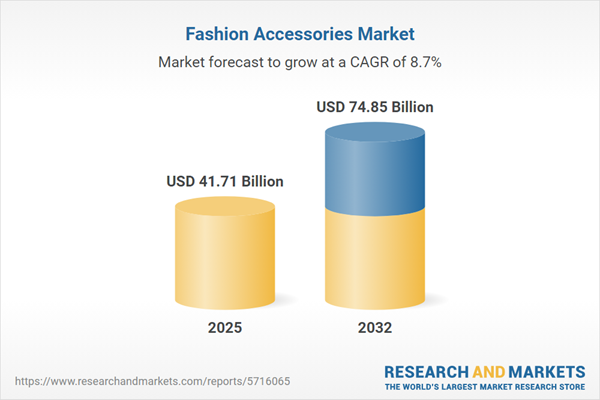Speak directly to the analyst to clarify any post sales queries you may have.
Senior executives in the fashion accessories sector must navigate ongoing digital change, evolving consumer expectations, and increasingly complex regulatory conditions. To maintain market leadership and organizational resilience, decision-makers are turning to precise, timely market research.
Market Snapshot: Fashion Accessories Market Size and Growth Trajectory
The global fashion accessories market reached USD 38.43 billion in 2024 and is set to expand to USD 41.71 billion in 2025, with projections indicating further growth to USD 74.85 billion by 2032, representing a CAGR of 8.68%. This positive trajectory is driven by the growing demand for both functional and stylish products, increasing emphasis on sustainable practices, and the accelerated shift to digital channels. Leading companies are reassessing their strategies to remain agile—adapting to new consumer behaviors while strengthening compliance and optimizing operational performance. These dynamics present both new challenges and strategic openings for senior decision-makers.
Scope & Segmentation of the Fashion Accessories Market
This research delivers detailed segmentation, supporting executive teams with insights crucial for regional diversification, product portfolio design, and competitive positioning:
- Product Types: Covers a range of accessories, including fabric and leather belts, various eyewear categories, purses, handbags, wallets, hats, technology-driven and traditional jewelry, scarves, and shawls. By examining these categories, stakeholders can enhance inventory planning and respond quickly to changing trends.
- Distribution Channels: Assesses sales performance and customer reach across retail, wholesale, boutiques, e-commerce, branded stores, and popular social commerce networks. Understanding the strengths of each channel enables brands to adjust resource allocation and tailor strategies for optimal results.
- Price Ranges: Explores the varied landscape of mass-market, mid-tier, and premium offerings, helping refine pricing approaches and address differentiation needs in competitive markets.
- Gender: Breaks down the market into men's, women's, and unisex categories, guiding targeted messaging and portfolio balance.
- Age Groups: Provides analysis from children to adults, enabling brands to nurture customer loyalty from early stages and adapt to generational demand shifts.
- Materials: Examines sourcing and impact of materials including cotton, silk, wool, synthetics, leather, metals, and plastics. This level of material insight enhances sustainability tracking and supply chain risk management.
- Regions: Delivers tailored intelligence for the Americas, Europe, Middle East and Africa, and Asia-Pacific. Regional context strengthens leaders’ ability to address compliance nuances and localize offers.
- Companies: Benchmarks key industry players such as LVMH Moët Hennessy Louis Vuitton SE, EssilorLuxottica SA, Kering SA, Chanel S.A., and Hermès International SCA, offering comparative analysis for partnership selection and competitive strategy.
Key Takeaways for Senior Decision-Makers
- Adopting personalization strategies and transparent sourcing builds stronger brand relevance as consumer values continue to diversify across markets.
- Advanced digital technology—including blockchain and augmented reality—enables deeper supply chain visibility, improved operational efficiency, and a seamless omni-channel customer journey.
- Regional adaptability in marketing and distribution is vital, helping companies address unique consumer preferences and navigate regulatory compliance in different markets.
- Strategic alliances with technology vendors and influencer-driven campaigns can accelerate growth in emerging sales channels and ensure brand offerings remain digitally competitive.
- Investment in ethical sourcing and circular business models positions organizations for resilience and aligns with evolving stakeholder sustainability expectations.
Impact of United States 2025 Tariff Measures on Fashion Accessories
Anticipated 2025 tariff measures in the United States are expected to increase cost challenges on imported fashion accessories. Senior leaders should evaluate supply strategies, diversify sourcing options, and deepen supplier partnerships. Continuous regulatory monitoring and close partner collaboration will be key to minimizing business exposure and maintaining margins through the transition.
Methodology & Data Sources
This report is rooted in direct executive interviews and in-depth assessment of verified industry and regulatory sources. Each data point has been externally cross-validated to ensure accuracy, enabling decision-makers to move forward with reliable insights.
Why This Fashion Accessories Market Report Matters
- Enables executive teams to confidently adapt to regional trends and evolving compliance requirements using accurate, current market data.
- Supports smarter product and pricing strategies by offering objective intelligence for supply chain management and channel optimization plans.
- Reveals high-potential categories and markets, empowering organizations to prioritize investments and refine entry and expansion strategies.
Conclusion
This research report gives senior leaders the actionable intelligence required to drive strategic transformation and agility, ensuring sustained organizational progress in a fast-changing global landscape.
Additional Product Information:
- Purchase of this report includes 1 year online access with quarterly updates.
- This report can be updated on request. Please contact our Customer Experience team using the Ask a Question widget on our website.
Table of Contents
3. Executive Summary
4. Market Overview
7. Cumulative Impact of Artificial Intelligence 2025
Companies Mentioned
The companies profiled in this Fashion Accessories market report include:- LVMH Moët Hennessy Louis Vuitton SE
- EssilorLuxottica SA
- Kering SA
- Compagnie Financière Richemont SA
- Chanel S.A.
- Hermès International SCA
- The Swatch Group AG
- Tapestry, Inc.
- Capri Holdings Limited
- Prada S.p.A.
Table Information
| Report Attribute | Details |
|---|---|
| No. of Pages | 194 |
| Published | October 2025 |
| Forecast Period | 2025 - 2032 |
| Estimated Market Value ( USD | $ 41.71 Billion |
| Forecasted Market Value ( USD | $ 74.85 Billion |
| Compound Annual Growth Rate | 8.6% |
| Regions Covered | Global |
| No. of Companies Mentioned | 11 |









